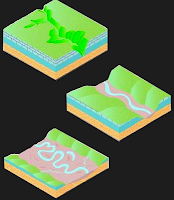The estuary is a transition ecosystem between rivers and ocean ― a zone influenced by marine phenomena like tides, waves, and the influx of salt water and riverine phenomena like fresh water flows and sediment transport.
 |
| Conceptual Diagram of an Estuary. Source: Louisiana Universities Marine Consortium (LUMCON) |
 |
| Blue Crab |
Sheltered estuarine waters support thriving communities of plants and animals especially adapted for this ecosystem.
To stand at the edge of the sea, to sense the ebb and flow of the tides, to feel the breath of a mist moving over a great salt marsh, to watch the flight of shore birds that have swept up and down the surf lines of the continents for untold thousands of year, to see the running of the old eels and the young shad to the sea, is to have knowledge of things that are as nearly eternal as any earthly life can be.
― Rachel Carson
 |
| Estuary of Klamath River in Redwood National Park. |
The nutrient cycle, the water cycle, and the cycle of life are the primary physical and biological phenomena found in estuaries:
- Nutrient Cycle - Many elements are recycled in estuaries providing sustenance to living organisms. The health of an estuary depends on a balance of these elements.
- Water Cycle - Evaporation occurs in estuaries and fresh water recharges ground water reserves.
- Cycle of Life - Estuaries provide food, shelter, and nurseries for animals. Decomposing animals provide nutrients for other organisms.
We need the tonic of wildness, to wade sometimes in marshes where the bittern and the meadow-hen lurk, and hear the booming of the snipe; to smell the whispering sedge where only some wilder and more solitary fowl builds her nest, and the mink crawls with its belly close to the ground.
― Henry David Thoreau
National Estuaries Day is an annual observation in the US held on the last Saturday of September.












